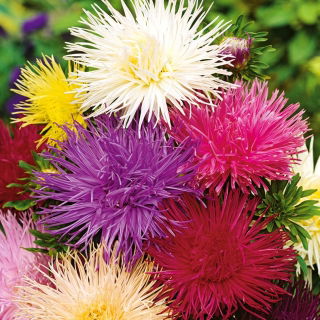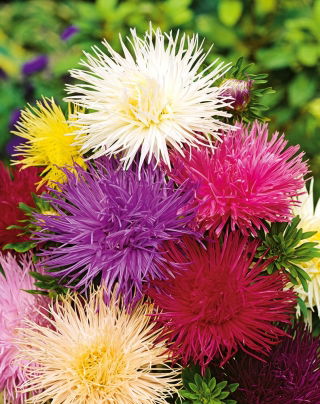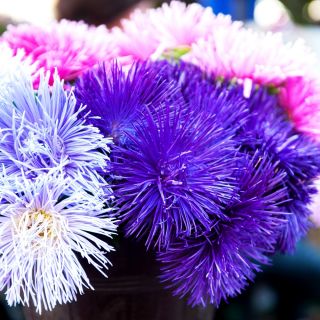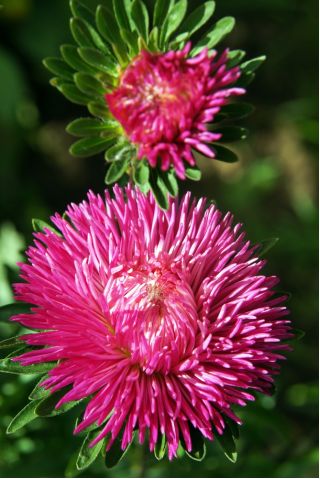The Aster, specifically the "Needle" variety, also known as Callistephus chinensis, is an exceptional annual plant that captivates with its vibrant appearance. Its needle-shaped flowers bring a unique charm to the garden, reaching a height of 50 to 80 cm. This makes it an ideal choice for enthusiasts of cut flowers and striking flower beds. The popularity of the Needle Aster stems not only from its aesthetic appeal but also from its ease of cultivation and versatile use in the garden.
Sowing
The Needle Aster is best sown in well-prepared soil that is moderately moist and fertile. Ensure the seeds are evenly distributed to promote uniform germination. Regular watering is important to prevent the soil from drying out.
Sowing Depth
The optimal sowing depth for the Needle Aster is approximately 0.5 cm. This helps protect the seeds from wind and heavy rain, facilitating proper germination.
Direct Sowing Period
When should Needle Aster seeds be sown directly into the ground? The best time for this is in April. Pay attention to the soil temperature, which should be slightly warmed to aid the germination process.
Sowing Period Under Cover
When to sow Needle Aster seeds under cover? Begin sowing in March or April. Covers protect young plants from unpredictable weather conditions, allowing for earlier development and preparation for transplanting.
Planting Time
The best time to plant Needle Asters is in May. By then, the plants are well-developed and ready to be transplanted to their permanent spot in the garden.
Plant Spacing
When planting, it is recommended to maintain a spacing of 20x40 cm. This provides the plants with enough space for unrestricted growth, avoiding competition for nutrients among their roots.
Companion Planting
The Needle Aster pairs beautifully with other ornamental plants such as marigolds, dahlias, and rudbeckias. This combination creates a colourful mosaic in the garden, drawing the eye and delighting the senses throughout the summer.
Site Conditions
The ideal location for the Needle Aster is a sunny or slightly shaded spot. The soil should be well-drained, rich in humus, with a neutral or slightly acidic pH. Regular watering, especially during dry spells, is crucial for lush growth and abundant flowering.
Growing Tips
The Needle Aster requires regular care, including consistent watering and fertilisation with multi-component fertilisers. Removing faded blooms encourages further flowering. It's also important to monitor the plants for any signs of disease or pests.
Plant Height
The plants reach a height of 50 to 80 cm, making them an excellent choice for both flower beds and as cut flowers for bouquets.
Flowering Period
The Needle Aster blooms from July to October. During this time, the plants adorn the garden with their bright flowers, adding joy and colour.
Usage
The Needle Aster is perfect as a cut flower, providing a lovely adornment for vases and bouquets. It can also be used to create colourful compositions in flower beds, where it forms striking arrangements with other plants.
Resistance to Diseases
The Needle Aster shows moderate resistance to diseases, but it's prudent to monitor the plants for powdery mildew and rust. Regular inspections and the use of appropriate plant protection products help maintain healthy and beautifully blooming asters.
Good to Know
The Needle Aster is a plant with a rich cultivation history and remains popular. Its diverse colours make it a frequent choice for home gardens and allotments. Regularly removing faded flowers extends the blooming period, and well-chosen fertilisers enhance the intensity of the colours.
Why Buy from Garden Seeds Market
Shopping at Garden Seeds Market ensures quality and satisfaction. With carefully selected seeds that undergo rigorous quality testing, customers can be confident they are receiving top-class products. The store offers quick and secure deliveries, along with attractive promotions. The positive reviews from satisfied customers attest to the professionalism and reliability of the service.
The seed packet contains 1 g of seeds. The packaging provides information on cultivation guidelines and the best sowing dates.












